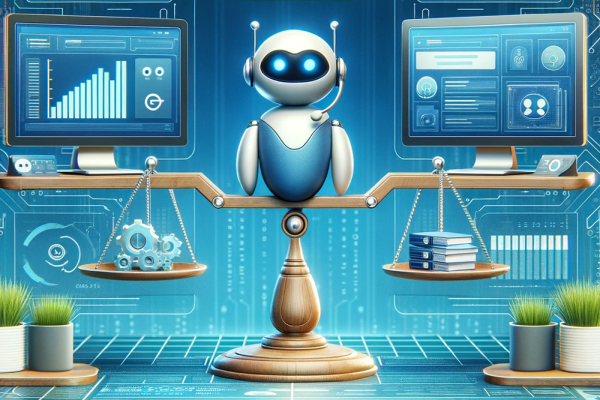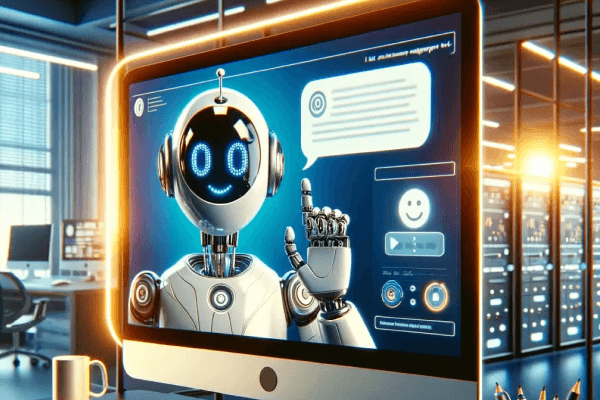So you’ve decided that you’re going to use an AI customer support chatbot to provide instant answers to your customers: that’s an excellent step to growing your business (companies that focus on improving customer experience increase revenue by 80%).
But how to choose which chatbot to use? This article will walk you through how to make the right choice to increase your customer satisfaction and reduce your customer support workload. We’ve separated out the key points you should consider when looking for a solution that suits you.
How to Choose the right AI Customer Support Chatbot for you
You’re company is thriving, your product is complex, and despite having comprehensive online documentation, customer queries still flood in. You’re committed to keeping your customers happy so you are working hard to respond to their queries quickly, but there are only so many hours in the day.
Many companies are increasingly turning to AI customer support chatbots to manage and reduce the volume of customer support tickets – but there are mixed results, so how do you choose the right chatbot to ensure you get great results?
Using the Right Tool for the Job
The key to selecting an AI chatbot lies in selecting one that matches your specific needs – there are different chatbots available for different situations:
Open-ended
Creative Responses
Flow Based
Sales Funnel
Accurate Answers
Customer Support
Accurate vs Creative Responses:
Do you need creative responses, or accurate high-quality responses?
- Accurate: If you need accurate responses, look for chatbots that offer guarantees against incorrect information and have robust anti-hallucination processes in place. Look for chatbots intended for your specific use-case, as the chatbot will have been trained to provide better answers for your specific use-case instead of hit-and-miss answers for a wide range of use-cases.
- Creative: AI chatbots can also be great at providing creative information, if left open-ended, multi-purpose, but at the risk of hallucinating (presenting incorrect information as facts). If you want creative unrestricted responses then an uncontrolled multi-purpose chatbot might be an appropriate solution.
Control (Funnel) vs Flexibility (Immediate Solution):
- Flow-based chatbots provide structured conversation paths but can struggle with complex queries. You can control every single answer, but this means you need to define every step and think of every potential question. Defining every step of the conversation may be more suitable for some sales-funnels, where perhaps your goal is to guide the customer to book a call etc instead of providing an instant answer to the customer.
- In contrast, using an AI chatbot that utilises a Language Learning Model (LLM) means the AI can understand each query and respond in line with how it has been told to respond, without the need for you to define each possible conversation route. This is most suitable for when you would like to provide an immediate support solution to the customer, not funnel them into further contact with you.
Specific knowledge required
Is there specific knowledge required (such as technical knowledge about your product), if so you’ll need to use a chatbot that can understand the provided information and guarantee only to use that reliable information. Such as ensuring the chatbot only talks about your product, and not irrelevant subjects. Look for chatbots that can quickly and easily be trained on your specific knowledge, and that include anti-hallucination measures. There are different ways to provide a chatbot with your specific knowledge, it can be as simple as a few clicks and done in minutes, or some solutions require custom coding and also take days/weeks to retrain a chatbot – make sure you look for solutions that will take care of the training for you and do so quickly.
When looking for the chatbot that’s right for you, bear in mind which type suits your use-case.
Choosing the Right AI Customer Support Chatbot
1. Setup Time
Time is valuable! A lengthy and complicated setup process for a chatbot can negate its benefits, or put you off all-together. Look for a chatbot that promises a quick and straightforward setup, ideally integrating seamlessly with your existing customer support systems and documentation.
- A free trial is only helpful if it is quick to get started!
- Quick Setup: If immediate ticket reduction is your goal, prioritize chatbots known for their simple and fast integration. Some chatbots will take effort to implement as you might need to design the chat flow – so to get going quickly look for a chatbot that is easy to start in minutes so you can quickly test it out and verify it is what you need.
2. Risk of Hallucination and Guarantee Against Incorrect Information
AI hallucination (where a chatbot presents incorrect responses as fact) can be a significant issue for some chatbots in customer support scenarios – you wouldn’t want to give the wrong answer to your customer. Therefore it’s essential to choose a chatbot equipped with advanced systems that minimize this risk. Look for providers who offer a guarantee against providing incorrect information, as this is crucial for maintaining trust and reliability in customer interactions.
3. Actual Running Cost and Avoiding Hidden Costs
The actual running cost of an AI chatbot is a critical consideration. Some providers have hidden costs associated with limited plans, API costs or by pricing using confusing terminology (such as pricing by “tokens”). Look for providers with a clear pricing structure, so you’re aware of all potential expenses upfront. Using a customer support chatbot can provide huge savings (of both money and time) but that saving can be lost if you overpay for an expensive chatbot.
- Look for a simple all-in rate, including clearly defined number of messages or conversations.
- Be aware of extra/hidden costs – some will charge a flat rate PLUS extra costs (extra costs may be an additional charge per message, per token, per conversation, or per resolution).
- Charging by token: some providers will provide a usage cap based on “tokens” which may not be a meaningful measure to you. If you only want your chatbot to provide very brief responses then this might be ok for you. If you want your chatbot to provide thorough and detailed responses, this will consume a lot of tokens and so look for chatbots that charge per message or per resolution. Also consider total cost (some might charge a flat rate PLUS costs per resolution or plus API costs).
4. Free Trial
A free trial period is invaluable. It allows you to test the chatbot’s capabilities, compatibility with your systems, and effectiveness in handling real customer queries. This trial period can offer insights into whether the AI chatbot meets your specific requirements without any financial commitment.
While considering this, also check for quick setup so you can meaningfully test the chatbot in minutes instead of days.
5. Money Back Guarantee
A money-back guarantee is a testament to a provider’s confidence in their product. It ensures that if the chatbot does not meet your expectations or fails to deliver promised results, you can reclaim your investment, mitigating financial risks.
6. What’s their focus?
There are some chatbots that come as part of a wider set of tools (such as ticket management, helpdesk etc with a chatbot bolted on the side) – the advantage of this is that all your customer support tools are in one place, however this does mean that the chatbot is not the main focus and as such could suffer on quality and lag behind on improvements. If you are looking for an all-in-one customer support package, then use the other items in this list to try to ensure the chatbot provided as part of the ecosystem is good quality.
If however that is not the case, then you will likely get a better service by opting for a dedicated chatbot provider, whose entire focus is ensuring the chatbot does a great job.
7. Integration with Existing systems
If you are looking to keep your existing ticketing system, then you should check if the chatbot provider is able to integrate with your ticketing system. This will mean that when a customer uses your chatbot, if they can’t get the answer they want they can still ask to talk to a human and will integrate in the method you choose to use (whether that be by email, Help Scout etc)
As there are thousands of ticketing systems out there, many chatbots won’t be able to list out all the systems they integrate with, so if you are unsure if a chatbot can integrate with your system we would suggest you drop them a line to ask – you wouldn’t want to miss out on your perfect chatbot provider when it could suit you perfectly!
Conclusion: The Balancing Act
In conclusion, selecting the right AI customer support chatbot involves a delicate balance between efficiency and reliability. It’s not just about reducing the number of support tickets; it’s about ensuring each customer interaction is accurate, helpful, and contributes to a positive user experience. The choice you make can significantly impact your customer satisfaction and retention.
Have you evaluated how an AI chatbot like Resolve247 can transform your customer support experience?
Resolve247.ai: The Ideal Customer Support Chatbot Solution
Bearing in mind all of the above, Resolve247.ai has been built to meet all of these requirements to provide you with the best possible customer support chatbot. This AI chatbot service specializes in prioritising accurate responses and reducing customer support tickets for businesses with comprehensive online documentation. With its quick setup and a focus on delivering accurate information, Resolve247 ensures reliable and trustworthy customer interactions to keep your customers happy.



